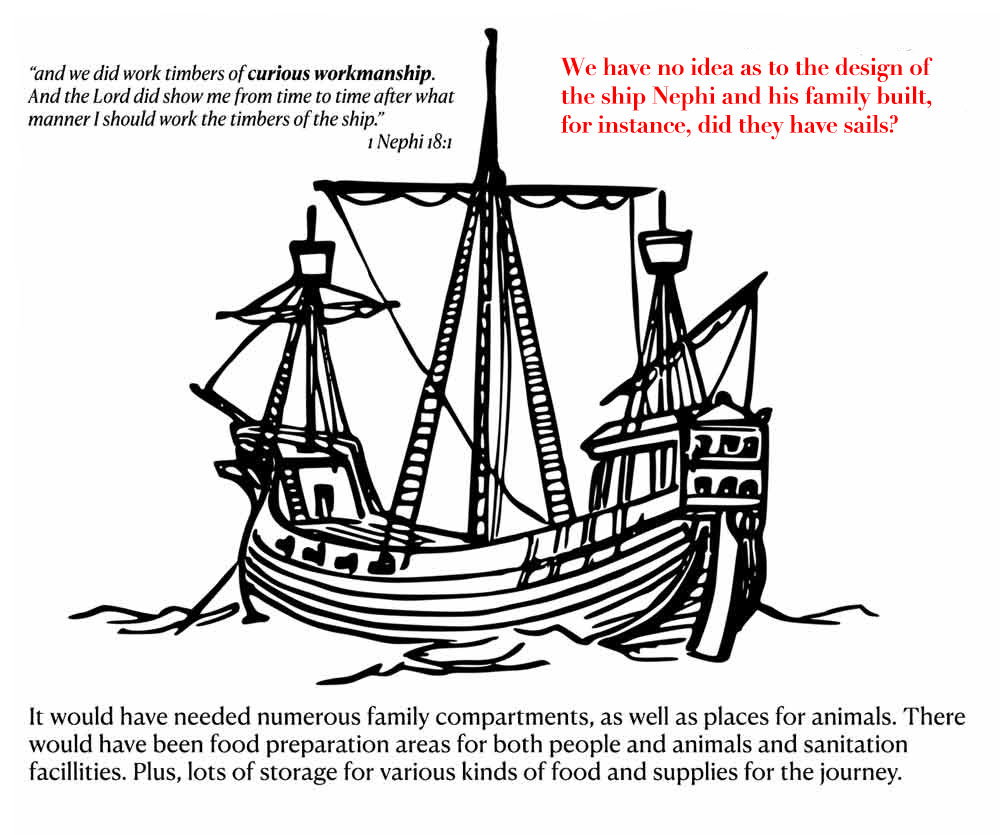In the numerous books and study guides that focus on Book of Mormon historical events, much attention is directed to personal interactions between Nephi and his brothers that occurred when Nephi was commanded to build a ship. Typically, details concerning their actual voyage and the passengers who sailed on the ship are overlooked. Though many details are lacking, this article strives to call attention to the numerous Book of Mormon passages that provide pertinent information.
Lehi groups’ families:
As we begin to determine how many sailed on the ship they built, we first recognize the fathers of the three family groups: Lehi, Ishmael, and Zoram. They are listed below along with their pertinent scriptural references:
- Lehi, Sariah, Laman Lemuel, Sam, Nephi (1 Ne. 2:5); Jacob, Joseph (2 Ne. 5:6); and daughters [2?] (2 Ne. 5:6)
- {Total for Lehi’s family: 10 or more}
- Ishmael, his wife, 5 daughters, and sons [2?] (1 Ne. 7:6) {Total for Ishmael’s family: 9 or more}
- Zoram (1 Ne. 4:35) {Total: 1}
Marriages and children:
Early in their journey, the sons and daughters paired off and marriages occurred. Here are the references that record those couplings:
“I, Nephi, took one of the daughters of Ishmael to wife; and also, my brethren took of the daughters of Ishmael to wife; and also Zoram took the eldest daughter of Ishmael to wife.” (1 Ne. 16:7) [It is assumed that the unnamed daughters of Lehi married the unnamed sons of Ishmael.]
All the couples had children: Laman (2 Ne. 4:3-7); Lemuel (2 Ne. 4:8-9); Sam (2 Ne. 4:11); Nephi (1 Ne. 18:19, 2 Ne. 1:30-31); Zoram (2 Ne. 1:30-32); sons of Ishmael (2 Ne. 4:10). Laman had “sons” and “daughters” (2 Ne. 4:3, 8) (obviously 4 or more children); so did Lemuel (2 Ne. 4:8).
“Our women did bear children in the wilderness. And so great were the blessings of the Lord upon us, that while we did live upon raw meat in the wilderness, our women did give plenty of suck for their children, and were strong.” (1 Ne. 17:1-2)
“Jacob and Joseph, also, being young, having need of much nourishment,…” (1 Ne. 18:19)

How many people were on the ship?
So, how many people sailed to their promised land, and what were their ages? Here is a basic count, plus varied guesses about the number of their children:
Basic count: Lehi & Sariah, 2; Ishmael’s wife, 1; seven couples: Laman, Lemuel, Sam, Nephi, Zoram, Sister 1, Sister 2, 14; plus Jacob and Joseph, [teenagers] 2. (Total basic count: 19)
Plus children: seven fertile couples, approximately 11 years after their marriages, before arriving in the promised land. If they were perhaps spacing their children one or two years apart, and apparently without deaths: perhaps four children per couple: 28; or five children per couple: 35; or six children per couple: 42; or seven children per couple: 49.
So plausible total counts (basic group plus children) of 47, or 54, or 61, or 68 are realistic! That would include a large number of children ages 2 to 10, plus a few young teenagers.
And with such a long voyage, a good number of new births probably occurred before the ship reached its destination.
The ship’s provisions and embarkation:
The scant information provided about the ship’s provisions, together with even conservative estimates concerning the number of passengers, make it very clear that the ship they constructed was sizeable. Think how large the ship had to be to transport all their provisions plus all those passengers!
“After we had prepared all things, much fruits and meat from the wilderness, and honey in abundance, … and our seeds, and whatsoever thing we had brought with us, everyone according to his age… we did put forth into the sea and were driven forth before the wind towards the promised land.” (1 Ne. 18:6, 8)
Distances traveled and estimated days at sea:
There is compelling evidence that their voyage ended in Central America, but that evidence isn’t part of this article. And there are numerous variables, such as the size and design of the ship, ocean water and wind currents, and how divine guidance and protection affected the length of their voyage. Yet, the following information provides realistic hypotheses for distance and time estimates:
- From Muscat, Oman to Tapachula, Mexico: 9,114 nautical miles; Pacific Ocean [Google maps distance calculation].
- That’s about 316 days (about 10¾ months) at 30 nautical miles per day. Landing: near Tapachula, Mexico. That is where their arrival was marked by the “Tree of Life”-carved stone, a marker which still remains there today.
- Or, from Muscat, Oman to Veracruz, Mexico: 10,702 miles; Atlantic Ocean [Google maps distance calculation].
- That’s about 362 days (almost 12 months) at 30 nautical miles per day.
Conclusion:
Theirs was a long, difficult, boring, journey. It involved many baby-tending and child-rearing responsibilities, and probably also ongoing interpersonal challenges involving already separating family factions following either Nephi or Laman and Lemuel.
Travel references:
In review, these several travel references are provided in the Book of Mormon.
- From Jerusalem to along the Red Sea. (1 Ne. 2:2-8) {c. 600 BC}
- From the Red Sea to Nahom, where Ishmael died (1 Ne. 16:6-34) [many days: 1 Ne. 16:15-17, 33]
- From Nahom to the land they called Bountiful (1 Ne. 17:1-6) [eight years] {c. 592 BC?} [Today’s name: Muscat, Oman.]
- Building the ship (1 Ne. 17:7-16, 18:1-4) {c. 590-589 BC?} Year estimates provided in the Book of Mormon are questionable. If they built the ship in only two years’ time it was a miracle!
- Arrival in the Promised Land (1 Ne. 17:23-25) {c. 589 BC}

